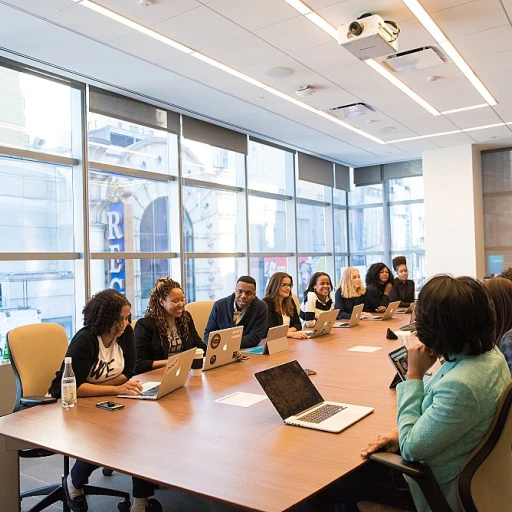Understanding the Employee Experience
Grasping the Essence of Employee Experience
Creating an exceptional experience for employees starts with understanding the factors that define and influence it. At its core, employee experience is the sum of all interactions an individual has with their employer, often spanning from recruitment right through to their eventual departure. These interactions encompass everyday exchanges, workplace atmosphere, professional growth opportunities, and everything in between.
An excellent employee experience isn't just a nice-to-have—it's a crucial aspect that can profoundly impact an organization's success. Happy, engaged employees are more productive, innovate efficiently, and often serve as the best ambassadors for attracting fresh talent. To lay a strong foundation, a grasp of innovative initiatives is vital in boosting employee experience and keeping the workforce motivated and aligned with the company's mission.
By identifying what's most important to employees, organizations can tailor experiences that not only meet expectations but exceed them. This means investing time in understanding the diverse needs and aspirations of the workforce and utilizing that insight to create a tailored and inclusive experience.
Next in our exploration are the cultural underpinnings that serve as the bedrock for fostering positive employee engagement. The journey into crafting a stellar employee experience has just begun!
The Role of Company Culture in Employee Engagement
The Influence of Company Culture on Engagement
When it comes to building an exceptional employee experience, company culture plays an indispensable role. At its core, company culture embodies the values, beliefs, and behaviors that determine how employees interact within an organization. It's a powerful force that shapes how employees perceive their work environment and influences their level of engagement.
A strong company culture fosters a sense of belonging and purpose, motivating employees to go above and beyond in their roles. It encourages collaboration, innovation, and a shared commitment to achieving the organization's goals. On the flip side, a weak or toxic culture can lead to disengagement, high turnover, and a decrease in overall productivity.
To develop a culture that enhances employee engagement, it is important to clearly define and communicate your company's core values. These values should guide decision-making and behavior at all levels of the organization. Leadership must also embody these values, serving as role models and fostering an inclusive environment where every employee feels valued and heard.
Additionally, creating opportunities for employees to connect with one another on a personal level enhances engagement. Whether it's through team-building activities, social events, or cross-departmental projects, fostering strong relationships improves collaboration and makes employees more invested in their work.
Another aspect of nurturing a positive culture is recognizing and celebrating achievements. Acknowledging individual and team accomplishments not only boosts morale but also reinforces commitment to the organization's mission. Recognizing efforts, both big and small, plays a crucial role in maintaining motivation and satisfaction.
For more insights on fostering a culture that enhances employee experience, you can explore our guide on
creating a thriving employee experience. Embracing these cultural practices within your organization is a stepping stone to nurturing engaged and enthusiastic employees.
Feedback and Communication: Keys to Improvement
{
"result": "
Enhancing Workplace Dynamics Through Effective Feedback and Communication
\n\nCreating a great environment for employees is a multifaceted endeavor, with feedback and communication serving as pivotal components. These elements, when harnessed effectively, elevate the employee experience, fostering an engaged and committed workforce. \n\nIn a thriving workplace, establishing open lines of communication is imperative. Employees need to feel valued and heard, a goal that can be achieved through regular feedback sessions and engagement surveys. By encouraging a dialogue-rich environment, companies can tap into their employees’ perspectives and insight, paving the way for innovation and growth. The blog
Unlocking the Power of Employee Feedback for a Thriving Workplace delves deeper into how such strategies can transform your organization.\n\nFurthermore, providing constructive feedback is just as important as receiving employee input. Leaders who develop a culture of transparency by giving clear and actionable feedback contribute significantly to an individual's professional development. This reinforces the company's commitment to each employee's journey, aligning with the broader organizational goals. Feedback, when approached correctly, empowers employees to improve and feel more connected to their work.\n\nSuccessful feedback and communication strategies also contribute to higher levels of employee engagement, a topic discussed in detail in other parts of this series. By embedding these practices into your company's culture, you not only meet current expectations but also set a strong foundation for sustaining a positive employee experience."\n}
Onboarding and Development: Setting the Stage for Success
Setting Up a Successful Onboarding Process
A seamless onboarding process is key to ensuring new employees feel welcomed and integrated into the company from the very start. First impressions matter, and an organized onboarding program can greatly influence how new hires perceive their roles and responsibilities. When employees feel confident and supported within their initial days, it boosts their morale and sets the tone for their journey within the organization.
A well-structured onboarding process should be comprehensive and engaging. Start by outlining clear roles and expectations while providing new hires with the necessary tools and resources. Consider implementing an onboarding buddy system, where a peer mentor can help newcomers settle into their new environment. This not only provides immediate support for the new employee but also encourages a culture of collaboration and camaraderie.
Furthermore, involve team members in onboarding events, orientation sessions, and social gatherings to foster a sense of belonging. When team members actively welcome and involve new hires in daily activities, it builds a strong team dynamic and encourages ongoing communication and support.
Learning and Development: Fueling Professional Growth
A cornerstone of a successful employee experience is the availability of growth opportunities. Employees who see a clear path for advancement within their company are more likely to be engaged and committed. Therefore, your organization should continually assess and develop training programs that align with both the personal goals of your employees and the strategic objectives of your business.
Providing diverse learning opportunities is crucial. Offer a mix of technical training, soft skills development, leadership workshops, and cross-department project collaborations. Employees crave variety and challenges, and by offering these, you'll not only keep them motivated but also help them acquire new skills that benefit your organization as a whole.
Moreover, encourage employees to pursue further education, whether through online courses, seminars, or advanced degrees. Incentivizing continuous learning with tuition reimbursement or flexible scheduling communicates your commitment to their professional development and solidifies their loyalty to the company.
Mentoring and Career Pathing
Establishing mentorship programs is an effective way to guide employees along their career paths. Pairing experienced professionals with less experienced employees helps foster knowledge transfer and personal growth. It not only accelerates skill development but also strengthens internal networks and nurtures a supportive work culture.
Additionally, implementing career pathing frameworks can significantly enhance employee satisfaction. Clearly outlining potential career trajectories within the organization provides motivation and direction for employees, as they can actively work towards specific career milestones. Regularly revisiting and adjusting these career paths based on the evolving business landscape ensures relevance and promotes long-term engagement. This thoughtful approach to onboarding and development lays a strong foundation for an outstanding employee experience.
Creating a Positive Work Environment
Fostering a Culture of Support and Inclusion
Creating a positive work environment begins with cultivating a culture of support and inclusion. Employees who feel valued and respected are more likely to be engaged and motivated. This means promoting diversity and ensuring that all employees, regardless of their background, have equal opportunities to succeed. Encourage open dialogue and provide platforms where employees can express their thoughts and share their experiences. By fostering an inclusive atmosphere, you lay the groundwork for a more cohesive and collaborative team.
Balancing Work and Life
A positive work environment also stems from recognizing the importance of work-life balance. Employers who respect and accommodate their employees’ personal lives, by allowing flexible work arrangements or supporting mental health initiatives, contribute to a healthier, more satisfying work environment. By prioritizing well-being, companies can reduce burnout and increase productivity, fostering a more sustainable and satisfying work life for everyone involved.
Investing in Workplace Facilities
The physical workspace is another critical aspect of the employee experience. Well-designed spaces that encourage collaboration, innovation, and comfort can significantly boost morale and productivity. Consider ergonomically designed office furniture, breakout areas for relaxation, and access to natural light. Furthermore, investing in technology and resources that facilitate efficient work can enhance employees' day-to-day experience, helping them perform at their best.
Make sure that your office layout promotes both focused individual work and team collaboration, allowing employees the flexibility to choose environments that best suit their tasks. In doing so, you show employees that their needs are taken into consideration, further nurturing a positive work environment.
Recognizing and Celebrating Achievements
Acknowledging employees' achievements and contributions is a significant component of a positive work atmosphere. Regularly celebrating successes, whether big or small, can boost morale and foster a sense of community. Implementing recognition programs that highlight employees' accomplishments can also encourage a culture of gratitude and positivity. When employees feel appreciated, they are more likely to strive for excellence and remain loyal to the company.
In conclusion, building a positive work environment requires intentional and ongoing efforts from leadership to create a culture that supports, values, and recognizes its employees. By doing so, organizations can enhance overall employee satisfaction and retention.
Measuring and Managing Employee Experience
Evaluating the Employee Journey
To truly craft an exceptional employee experience, businesses must evaluate and manage the entire employee journey with care and precision. Just as one would scrutinize customer interactions, understanding how employees perceive and engage with the organization is crucial. This begins with developing a robust strategy for capturing insights into employee satisfaction and engagement.
Key Metrics for Evaluation
Effective measurement of the employee experience involves a combination of quantitative and qualitative approaches. Surveys, often utilized to gauge employee sentiment, should be well-designed, focusing on key areas such as job satisfaction, alignment with company values, and perceived growth opportunities. Regular pulse surveys are an excellent tool for capturing real-time feedback while maintaining the momentum of ongoing communication.
Analyzing Feedback for Continuous Improvement
Once data is collected, it is essential to analyze it systematically to identify trends and areas for improvement. Analytics tools can provide deeper insights into employee behavior and highlight potential gaps or issues in engagement and productivity. This phase is closely linked to communication, where results are not just used internally but shared transparently with employees, emphasizing the organization’s commitment to their well-being.
Taking Action: Closing the Feedback Loop
The true value of measurement lies in taking actionable steps based on insights gained. This requires organizations to operate not in a reactive state but proactively address concerns and celebrate successes. By developing and implementing solutions, whether within onboarding processes, development programs, or adjusting company culture initiatives, companies demonstrate their dedication to fostering a positive employee experience, thus enhancing overall engagement and loyalty.
Regular Review and Adaptation
An exceptional employee experience is not static but evolves with the needs and demands of the workforce. Therefore, organizations should establish a rhythm of regular reviews and updates to their employee experience strategies. As changes occur within the company or in broader external contexts, maintaining flexibility and adaptability ensures that the employee experience remains relevant and effective.







